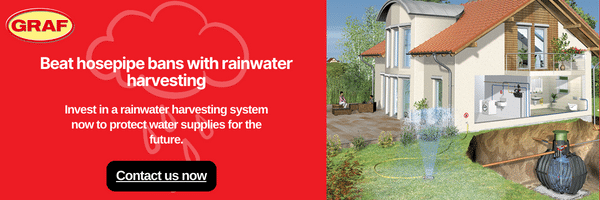Posted by Callum Vallance-Poole, on May 1, 2023.

We understand that saving money and being environmentally conscious are important to you. One way to do this is by conserving water during times of drought or water shortages. In this post, we’ll explore what a hosepipe ban is, why it’s in place in the UK, and how you can save water during a hosepipe ban.
What is a hosepipe ban?
A hosepipe ban is a temporary measure that prohibits the use of hoses for non-essential purposes, such as watering gardens or washing cars. The aim of a hosepipe ban is to reduce the demand for water during times of drought or other water shortages. In the UK, these bans are typically put in place by water companies when the water level in reservoirs are below average.
Why are hosepipe bans in place in the UK?
As we’ve seen in recent news, South West Water has announced a hosepipe ban in Devon due to a prolonged period of low rainfall. The region, along with Cornwall, East Anglia, and Isles of Scilly, is still in a drought that began last year. With another hot and dry summer expected this year, there is a risk of further water shortages across the country. Hosepipe bans are one way to help conserve water and ensure that supplies remain sufficient for essential uses.
Why Should You Care About Hosepipe Bans?
Even if you don’t live in an area that is currently affected by a hosepipe ban, there’s a good chance that you may be affected in the future. With climate change leading to more frequent and severe weather events, droughts and water shortages are becoming more common. By reducing your water usage, you can help to conserve water and ensure that supplies are available for essential uses, such as drinking, washing, and sanitation.
Six Ways to Save Water During a Hosepipe Ban:
- Water your plants in the early morning or late evening to reduce evaporation. – When you water your plants during the heat of the day, much of the water will evaporate before it has a chance to be absorbed by the soil or taken up by the plant roots. To prevent this, water your plants early in the morning or late in the evening when the temperatures are cooler and the sun is less intense. This will help to ensure that the water you use is actually benefitting your plants.
- Use a watering can instead of a hose to water your plants. – When you use a hose to water your plants, much of the water can be lost to evaporation or runoff. By using a watering can instead, you can target the water directly to the base of the plant and avoid wasting water on areas that don’t need it. This can also help reduce your overall water usage.
- Take shorter showers and turn off the tap while brushing your teeth. – Reducing the amount of water you use in your daily routine can have a big impact on your overall water usage. One easy way to do this is to take shorter showers and turn off the tap while you’re brushing your teeth or shaving. This can save a significant amount of water over time and help to reduce your water bill
- Fix any leaks or drips in your plumbing to prevent wasted water. Even small leaks or drips in your plumbing can waste a surprising amount of water over time. To prevent this, it’s important to regularly check your plumbing for any leaks or drips and have them repaired as soon as possible. This can help reduce your water usage and prevent wasted water.
- Install a water butt or above-ground rainwater harvesting tank to collect rainwater for use in your garden. Although you might be thinking, we’re in a drought, so surely there is no rain, and therefore what’s the point of getting a water butt? But just because parts of the country are officially in drought doesn’t mean it won’t rain at all. You can have the heaviest of rain storms and still be in drought because, although it feels like it’s raining a lot, it’s still not enough to top up water levels. You can still benefit from this rain if you have a water butt or rainwater harvesting system, though. It is still likely to rain occasionally, and you can make the most of it when it does. A water butt is a container that collects rainwater from your roof, which you can then use to water your plants, wash your car, or for other non-drinking purposes. By using rainwater instead of tap water, you can reduce your water usage and help conserve this valuable resource. You can purchase water butts from most hardware stores or online retailers.
- Use a bucket of water instead of a hose to wash your car. When you wash your car with a hose, you can use a lot of water in a short amount of time. To reduce your water usage, try using a bucket of water instead. This will help to ensure that you use only the amount of water you need and can also prevent runoff and waste.
Hosepipe bans may seem like a minor inconvenience, but they serve an important purpose in conserving water and ensuring that essential supplies are available. By following these simple tips, you can do your part to reduce your water usage and help protect this valuable resource for future generations.

